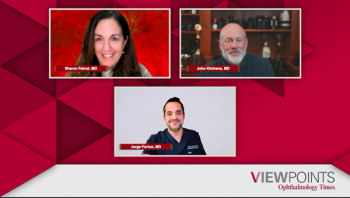
Throwback Series: Identifying and treating neovascular lesions in pregnancy

SriniVas R. Sadda, MD, FARVO, recalls a residency case that highlights the transformative impact of OCT and OCT angiography.
In celebration of Ophthalmology Times’ 50th anniversary, we invited leaders in ophthalmology to revisit a memorable “throwback” case from earlier in their careers. In this special series, they reflect on how evolving knowledge, techniques, and technologies have transformed the way such cases are managed today. Join us as we look back at pivotal moments in their professional journeys—and explore how far the field has come.
This episode focuses on the case of a young woman patient who was pregnant and who presented with sudden vision loss. The case highlights just how transformative today’s imaging and treatment advances have been—and how they might have changed her outcome. Faced with limited imaging options before the days of OCT and OCT angiography, the ophthalmologist in this case—SriniVas R. Sadda, MD, FARVO—had to balance caution and clinical judgment without the clarity modern tools now provide.
Sadda serves as the Director of Artificial Intelligence and Imaging Research at the Doheny Eye Institute and is a Professor of Ophthalmology at the UCLA Geffen School of Medicine. He previously served as President of the Doheny Eye Institute. He earned his medical degree from Johns Hopkins University, where he also completed his ophthalmology residency along with fellowships in neuro-ophthalmology and medical retina at the Wilmer Eye Institute in Baltimore, Maryland.
Sadda recalls this memorable case from his residency in his own words: “I recall very well a patient of mine, a young lady, I think she was around 21-22 years old, who was in her second trimester of pregnancy and came into my resident clinic. When I was a resident, we had an independent resident clinic. We obviously had some faculty supervision, but in any event, she came in with vision loss in one eye, and she had evidence of what looked like either an inflammatory lesion or corneal neovascularization. She was a mild myope and there were some areas that suggested a condition that sometimes one might call punctate inner choroidopathy, which can be complicated by neovascularization.”
At the time, photodynamic therapy was not yet available, and thermal laser was the standard approach. Sadda recalled that the lesion appeared to be just outside the fovea but close enough that precise localization was critical: “I couldn't tell. It's something that we normally would laser, but before you would laser that, you'd want to define the boundaries of the neovascularization, and you'd want to make sure that it was something you could safely laser. And of course, you couldn't tell just by examination, and you'd have to rely on imaging, and this was before we had OCT and certainly before we had OCT angiography, so we relied on fluorescein angiography to make this diagnosis and to guide treatment.”
Pregnancy added complexity. The patient was hesitant to undergo fluorescein angiography, and Sadda was reluctant to apply laser without precise localization. “And so ultimately, we ended up trying steroids for her, which didn't really seem to help. It really looked like it probably was neovascularization, but I couldn't be 100% sure, and we ended up waiting it out until after she delivered.” Postpartum, her vision worsened slightly, and fluorescein angiography revealed a neovascular membrane encroaching toward the center and beginning to scar. The decision was made not to treat immediately; the patient’s vision eventually stabilized, though some loss occurred, while her fellow eye remained unaffected.
Reflecting on the case in the context of current imaging capabilities, Sadda notes: “Thinking to now, we obviously have tools like OCT, but also OCT angiography, where we can noninvasively visualize the neovascularization. And I would have been able to identify that. I would have known that it was neovascularization, not just an inflammatory lesion. I'd have known exactly where it was, and I would have been able to treat it right at the get-go, and that could have led to potentially a better visual outcome for this patient.”
He also emphasized the impact of modern therapies: “Certainly, having imaging to allow us to make a more specific diagnosis would have allowed us to make the best decision for this patient.” This case highlights the diagnostic and treatment challenges faced before OCT and OCT angiography, and underscores the significant advances that have transformed the management of retinal disease today, he added.
Newsletter
Don’t miss out—get Ophthalmology Times updates on the latest clinical advancements and expert interviews, straight to your inbox.






































